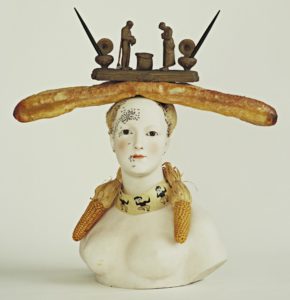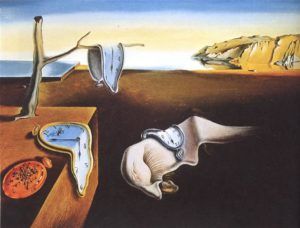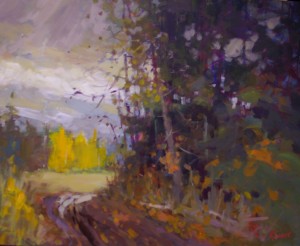Dear Artist,
Yesterday, Edward Vincent of Sydney, Australia wrote, “You often mention ‘contemplating’ a work in progress. I’ve found discussing a painting issue ‘out loud’ in private to be productive. Thoughts alone seem to be much easier to muddle up and lose track of than audible words. What do you think of this idea?”

Retrospective Bust of a Woman, 1933
Painted porcelain, bread, corn, feathers, paint
on paper, beads, ink stand, sand, and two pens
29 x 27 1/4 x 12 5/8 inches
by Salvador Dalí (1904-1989)
Thanks, Ed. Brilliant. Now that you’ve let Joey out of the front pocket, I’ll fess up — I’ve been doing it myself for years. Oh, I’ve been caught a few times by people who walked into the studio without knocking. What’s really embarrassing is when the painting is doing the talking — often in a high, squeaky, wounded sort of voice. Long ago, Robert Henri noted, “There’s no art without contemplation.” I first grabbed that quote when I was in high school. My earliest contemplations were mere pauses while I gave my work a “second opinion.” In those days I used to make written notes before I went back in. Later, I found my short-term memory to be good enough. Properly matured, the contemplation process is a combination of cruising for major errors, picking up specific minor but fixable boo-boos, and re-asking “what could be?”
Out loud, the conversation can go something like this:
Artist: “You’re boring me.”
Painting: “I’m sorry.”
Artist: “You’re too fiddly.”
Painting: “You could solidify me here with a dash of colour.”
Artist: “Good idea. Also, that little thing is not standing in front of that other thing.”
Painting: “That should be no trouble to fix.”
Artist: “But you still look jumpy and out of whack.”
Painting: “See what I’m like in black and white.”
Artist: “And now you’re lacking in warmth and colour surprise.”
Painting: “What about giving me a swipe of really orange sunset behind everything?”
Artist: “Okay. I’ll do it.” Painting: “I love it when you are so positive and just sock it to me.”
You can see by this sample that it’s largely a matter of letting the painting tell you what it needs. While it’s all about surrendering to the work itself, it’s also the quality of the dialogue in front of it. Well-chosen words sop up the follies of defeat and error. As the lady said, “How do I know what I think until I hear what I say.” Sometimes it’s a loud and raucous shout. Sometimes it’s a barely-audible whisper.
Best regards,
Robert
PS: “What we plant in the soil of contemplation, we shall reap in the harvest of action.” (Meister Johann Eckhart)
Esoterica: A verbal studio is more likely to be an active studio. I’ve noticed the better paintings, nearing the finish line, can receive an enthusiastically blurted “yes!” For the most part this unexpected outburst happens when the design is crisp, there’s some sort of drama, and abstract elements give the work more interest than the thing it’s meant to depict. “Please, please, take pity on me and desert me now,” says the painting. “Where’s another blank canvas?” asks the artist.

Debris of an Automobile Giving Birth to a Blind Horse Biting a Telephone, 1938
Oil on canvas
21 1/2 x 25 5/8 inches
by Salvador Dalí
This letter was originally published as “Talk to me” on December 27, 2011.
Have you considered a Premium Artist Listing? With each letter, an artist is featured at the bottom of this page. The Premium Artist Listings are a means of connecting artist subscribers through their work. Proceeds from each listing contribute to the production of The Painter’s Keys.
“To gaze is to think.” (Salvador Dali)
Featured Artist
My art represents an artistic journey that has been on-going for more than thirty-five years with help and guidance from many wonderful artists. Now, with years of plein-air painting experience, study and solo exhibitions, I believe that my current work has reached its highest level, reflecting the depth of my absorption in the wonder and beauty of the world around me. I have learned that, as an artist, I will never stop looking for better ways to express my feelings in art and that struggling to more fully understand myself is integral to my painting; a philosophy that was part of every workshop I taught. Still is.






16 Comments
How wonderful to read this today, the last Painter’s Key of 2020! I’m going to try the out loud conversation today with a painting I am working on now. i wasn’t sure what to do yesterday. I hope the painting will tell me what’s needed today.
Thank you for sharing your father’s inspiring words once again Sara.
Thank you for this! I am just starting out as an artist and I love this idea, and now that I think of it I believe I have even done it naturally a few times already. I will key into it more now for sure! Xx Elisabeth
Talking to myself has always been forbidden. Another no-no I can leave behind. Today is the day to begin something new.
Karen – love your choice of “leaving behind” the things we are taught since birth as no no’s, as if there is something wrong about turning to the self – The I AM. Ultimately and after long contemplation it seems that the I AM is all there is, just splattered in tiny droplets of expressions across the cosmic sea.
Have one that’s been on and off the easel a few times. Dialogue is on going but I think we’ve reached an agreement. Sometimes a painting is finished, period, no more discussion. Time to move on.
Thanks again.
Oh, I love this. Somehow I missed this letter when Robert first sent it out, but I always talk with my students about the process of creation being a conversation between the artist and the painting.
And I too talk to myself (though I haven’t yet answered back as the painting! I love it!). When my dog was alive, and would lay near the foot of the easel, if I suddenly realized someone was near and probably thinking I was nuts, I would look at her and say, “Isn’t that right, Zoe?” with a grin. She would generally look up at me and give me coverage. ;-)
One of Robert’s best letters IMO. And whenever there’s a quote by Robert Henri it adds the punctuative. Not sure about the Dali horse birthing painting though. Makes me think of the quote, “Just because you can paint something doesn’t mean you should.” (Maybe attributable to Joe Blodgett?)
So I am not crazy…just having a conversation with an inanimate canvas until I instill within in it a life force.
Well, must say, like kids, they do have a mind of their own. All the talking in the world to them and they still insist on doing their own thing. Doesn’t stop me from talking, tho, I am less frantic now because it seems they have matured enough to surprise me with some unexpected success. :)
That was super helpful, especially the sample conversation & quotes. Thank you!
thank YOU as always – bringing me great pleasure :) … and contemplation
now back to talking to my self (and my art)
Happy new Year to all, hope this year keeps you in good health xox
Paintings by Julie Northey on facebook, http://www.society6.com/julienorthey
hahaha… I always have conversations with my work:):) be it painting, pottery or any creative piece:):)
Sometimes the fix is onerous, after days of pondering. One picture, recently, sat on my drying easel for several weeks before I put one short mark on it. Voila! Perhaps it’s my failing, but almost nothing is finished immediately.
There are people in this world who don’t have an inner dialogue with themselves (yes, that a real thing!) and I often wonder how many of these people are artists?
Interesting! I too have conversations with paintings! I think it’s an essential first step before the brush gets wet while the painting is still in my head while the eyes look.
I long ago developed a habit of talking to myself (actually talking back to and with the work in progress) when I was a software engineer. Code, like pictures, often needs a conversation – a real, audible conversation – to progress properly. I still do it no matter what I’m working on, whether code, a painting, a crochet project or anything else. I just like to talk back and forth to and with my work. It seems so natural – and very helpful! But it always seems to surprise people, too, especially in a class. Most people seem curiously embarassed to be caught out “talking to themselves.” I always encourage them to go for it!